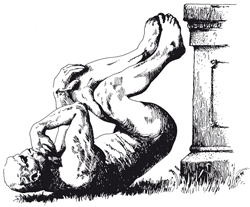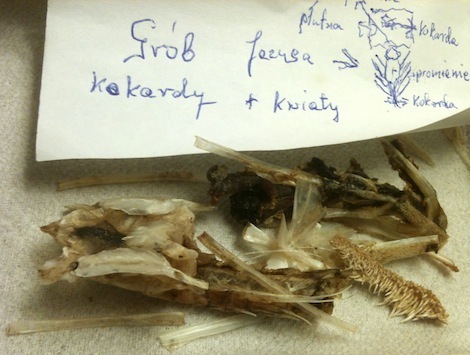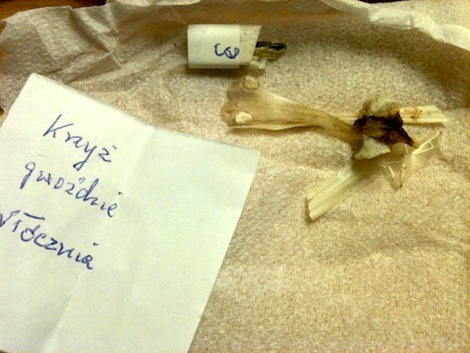Marc Abrahams's Blog, page 533
November 24, 2012
In search of Grollman’s remembered vacuum incident
My column this week in The Guardian, looking back at medical reports about the epidemic of penile amputations in Thailand, inspired this letter from a reader, which the newspaper published on November 23:
I’m afraid your Improbable research piece (An epidemic of penile amputation, explained, 20 November) brought back to me something I foolishly read in the 1973 Journal of Plastic and Reconstructive Surgery, while working at the HK Lewis medical library. It featured a man who had severed the head of his penis while hoovering iron filings from his underpants (don’t ask). He obviously got patched up OK, and I hoped the story wasn’t going to accompany me to the grave, but clearly it is.
—Tim Grollman, London
I have tried to find the article Mr. Grollman refers to. I believe that the article was published not in the Journal of Plastic and Reconstructive Surgery, but rather in a different journal:
“Laceration of penis from hand vacuum cleaner,” Robert Zufall, Journal of the American Medical Association [JAMA), vol. 224, no. 5, 1973, pp. 630.
I have been unable to obtain a copy of that report by Dr. Zufall — it seems to be missing from the JAMA web site — and would be grateful if someone could find and send me a copy. There may be medically significant details that ought be brought to the public’s attention.
I did find two letters that JAMA published in response to Dr. Zufall’s letter:
“Penile Laceration,” Rodney A. Mannion, JAMA, vol. 224, no. 13, 1973, p. 1763. Dr. Mannion writes: “I have had a patient with this injury who admits to this practice, and a number of urologists also have had similar cases as we discovered at a meeting of the New England Section of the American Urologists Association in October 1972. Many of the urologists present knew of this injury. I would paraphrase Zufall’s letter, ‘So beware! It is more common than you think.’”
“Vacuum Cleaner and Penis,” Ian Kennedy, JAMA, vol. 225, no. 10, 1973, pp. 1250-1250. Dr. Kennedy writes: “Dr. Zufall’s letter about the vacuum cleaner reminds me of a similar case I had, supposedly due to a dog bite! Privacy and the look of incredulity on my face brought the confession that the vacuum cleaner was being used as a novel way of masturbating, with alarming results.”
(Thanks to investigator Annette Smith for bringing the Grollman letter to my attention.)

“compared to being primed with a dwarf”
One of Diederik Stapel‘s many scholarly studies that have been retracted was, apparently, the only published scholarly study that included the phrase “compared to being primed with a dwarf.” The study itself is now one of the few scholarly studies to both (a) fixate on Santa Claus’s attributes and (b) be retracted.
The Retraction Watch blog has been covering the Stapel story with spirit and diligence. This is how Retraction Watch describes the Santa-Claus-attributes-/-dwarf paper retraction:
Diederik Stapel notches retractions 29, 30, and 31
… The following article from the European Journal of Social Psychology, “Staff, miter, book, share: how attributes of Saint Nicholas induce normative behavior” by Janneke F. Joly and Diederik A. Stapel, published online on 14 January 2008 in Wiley Online Library (wileyonlinelibrary.com), has been retracted by agreement between the co-author, the journal Editor in Chief, Tom Postmes, and John Wiley and Sons Ltd. The retraction has been agreed upon following the results of an investigation into the work of Diederik A. Stapel (https://www.commissielevelt.nl/). The Levelt Committee has determined that this article contained data that were fabricated by Diederik A. Stapel. His co-author was unaware of his actions and not in any way involved.
A copy of the Santa Claus / dwarf paper is available elsewhere online (or was, anyway, at the moment this blog item — the one you are reading — was being published).

Sex in cheese
Though sometimes discussed (and perhaps sometimes observed) by cheesemakers, sex in cheese was, officially, to some extent a theoretical occurrence until the publication of this new study, which was performed in France:
“Sex in Cheese: Evidence for Sexuality in the Fungus Penicillium roqueforti,” Jeanne Ropars, Joëlle Dupont, Eric Fontanillas, Ricardo C. Rodríguez de la Vega, Fabienne Malagnac, Monika Coton, Tatiana Giraud, Manuela López-Villavicencio [pictured here], PLoS ONE 7(11), November 21, 2012 e49665. The authors are variously at Muséum National d’Histoire Naturelle, Paris; Université Paris-Sud, Orsay; Université de Brest, UEB; ESMISAB, Technopôle Brest-Iroise, Plouzan; and UFR des Sciences du Vivant, Paris. They report:
“Although most eukaryotes reproduce sexually at some moment of their life cycle, as much as a fifth of fungal species were thought to reproduce exclusively asexually. Nevertheless, recent studies have revealed the occurrence of sex in some of these supposedly asexual species…. Here, we investigated the sexual capability of the fungus Penicillium roqueforti, used as starter for blue cheese production. We present indirect evidence suggesting that recombination could be occurring in this species. The screening of a large sample of strains isolated from diverse substrates throughout the world revealed the existence of individuals of both mating types, even in the very same cheese. The MAT genes, involved in fungal sexual compatibility, appeared to evolve under purifying selection, suggesting that they are still functional. [Evidence] reinforces the conclusion that P. roqueforti underwent more or less recent sex events. In this species of high industrial importance, the induction of a sexual cycle would open the possibility of generating new genotypes that would be extremely useful to diversify cheese products.”
BONUS: A possibly exciting video about Roquefort cheese:

November 23, 2012
Flamingo Stance in Humans — Good and Bad
Another paired entry in the category of “Is a thing good or bad? It Depends”. In this case the thing is people standing on one leg. Here are two studies:
“Dynamic flamingo therapy” [Article in Japanese], Sakamoto K., Clinical Calcium. 2008 Nov;18(11):1594-9. (Thanks to investigator Genevieve Jules for bringing this to our attention.) The authors is at Showa University School of Medicine.
“A long follow up study of one minute unipedal standing therapy 3 times in a day to prevent femoral neck osteoporosis that have started from 1993 was reported. The registration from July 1993 to March 2004 were 86 cases which measured the femoral neck bone mineral density according to dual energy x-ray absorptiometry in a follow-up period…. According to a randomized controlled study of unipedal standing balance therapy to clinically defined high-risk elderly individuals a therapy group reduced fall times by a significant difference than non-therapy group. We conclude that unipedal standing therapy is efficacious against femoral neck osteoporosis and fractures.”
and:
“Treatment of abnormal single-leg stance (flamingo) radiographs. Opinion: nonoperative treatment; opinion: operative fixation, anterior plating,” Sanzone AG, Heiney JP, Marsh JL, Olson SA., J Orthop Trauma. 2011 Jan;25(1):e9-11. The authors are at Trauma and Fracture Specialists Research and Education Foundation, San Diego, CA, USA.
BONUS: Flamingos standing like humans who stand like flamingos:
BONUS: Why do flamingos stand on one leg?

November 22, 2012
TODAY: Ig Nobel “Science Friday” broadcast
 In America, science has a great day-after-Thanksgiving tradition (we say immodestly): the special Ig Nobel Prize broadcast on National Public Radio’s Talk of the Nation — Science Friday program.
In America, science has a great day-after-Thanksgiving tradition (we say immodestly): the special Ig Nobel Prize broadcast on National Public Radio’s Talk of the Nation — Science Friday program.
This specially edited version of the year’s Ig Nobel Prize ceremony will be the first hour of the two-hour Science Friday program. In most—but not all!—cities this will be from 2:00-3:00 pm. (Some NPR stations schedule it at other times.) Many stations also stream the broadcast online, so you can listen (almost) no matter where you are.
Today, Friday, November 23, 2012, gather the family and join Science Friday host Ira Flatow [shown here with what we hope is one of his most colorful ties] for the big broadcast.
BONUS: If you’re impatient and can’t wait, here’s last year (2011)’s SciFri Ig Nobel show, and here’s the 2010 broadcast.

Gamification and deGamification
 The origin of the word ‘Gamification’ is not entirely certain, but some attribute it to professor Richard Bartle FRSA of the School of Computer Science and Electrical Engineering at the University of Essex, UK who was working on MUD circa 1980. The exact meaning of the word is slightly fuzzy around the edges too - but the Collins English Dictionary for example defines it as : “To adapt (a task) so that it takes on the form of a game”. In the last couple of years, a flurry of activity has emerged regarding the gamification of business practices. For example publications see the work of Dr. Deterding, Affiliate Researcher at the Hans Bredow Institute for Media Research, Hamburg University. e.g. Situated motivational affordances of game elements: A conceptual model. But perhaps gamification shouldn’t be applied with too broad a brush – what may be a useful model for a ticket sales company might not be so appropriate for, say, a funeral parlour business. And so, if a ‘gamification’ business paradigm is found to be inadequate or even, as sometimes happens, is criticised as puerile, then ‘de-gamification’ might be called for. And de-gamification has now also been covered in academia - see for instance the inaugural issue of G|A|M|E journal. +10! Gamification and deGamification. Some have even asked if gamification is broken. Are we perhaps heading for an era post-gamification?
The origin of the word ‘Gamification’ is not entirely certain, but some attribute it to professor Richard Bartle FRSA of the School of Computer Science and Electrical Engineering at the University of Essex, UK who was working on MUD circa 1980. The exact meaning of the word is slightly fuzzy around the edges too - but the Collins English Dictionary for example defines it as : “To adapt (a task) so that it takes on the form of a game”. In the last couple of years, a flurry of activity has emerged regarding the gamification of business practices. For example publications see the work of Dr. Deterding, Affiliate Researcher at the Hans Bredow Institute for Media Research, Hamburg University. e.g. Situated motivational affordances of game elements: A conceptual model. But perhaps gamification shouldn’t be applied with too broad a brush – what may be a useful model for a ticket sales company might not be so appropriate for, say, a funeral parlour business. And so, if a ‘gamification’ business paradigm is found to be inadequate or even, as sometimes happens, is criticised as puerile, then ‘de-gamification’ might be called for. And de-gamification has now also been covered in academia - see for instance the inaugural issue of G|A|M|E journal. +10! Gamification and deGamification. Some have even asked if gamification is broken. Are we perhaps heading for an era post-gamification?

Analysis of the mystery bones
A package arrived here, at our offices in the US, from a man in Poland. The package contained a letter and several little collections of tiny bones. (Each little collection was wrapped in its own piece of paper, and contained, in addition to the bones, a tiny slip of paper with a few words written on it.) The writing was all in the Polish language — which alas we do not read.
We took photos, several of which you can see here, and sent those photos to colleagues in several European countries, asking if they could tell us the meaning of these objects. Here are replies from two forensic scientists:
From a forensic scientist: ”These are fishbones, and judged from the enclosed jawbones they are most probably from a Zander (Stezostedion lucioperca)”
From another forensic scientist: “My Polish colleague has studied the letter and notes. As expected, it is the work of a nut case. He cooked the head of the fish and, in the separate bones, discovered a pattern that reflects the suffering and subsequent death of Jesus Christ. He urges us to use modern scanning techniques to see the same. The writings are of an illiterate person. The stationary paper is of a famous polish university (Copernicus University), just visible on the picture on the lower edge.”




November 21, 2012
How Mathematicians wonder: The Riemann hypothesis
 The Riemann hypothesis [the tiny photo here shows Riemann, he who hypothesized] fascinates an uncountable number of mathematicians. Many have tried, tried, tried to prove that it’s true. The problem is not easy. Here’s proof, of a sort, of how not easy it is. The following passage appears on page 100 of Ricardo Perez Marco [pictures here in a photo larger than the miniature of Riemann]‘s treatise called Conclusion and comments on the Riemann Hypothesis” [Jornadas Sobre los Problemas del Milenio, Barcelona, del 1 al 3 de junio de 2011]:
The Riemann hypothesis [the tiny photo here shows Riemann, he who hypothesized] fascinates an uncountable number of mathematicians. Many have tried, tried, tried to prove that it’s true. The problem is not easy. Here’s proof, of a sort, of how not easy it is. The following passage appears on page 100 of Ricardo Perez Marco [pictures here in a photo larger than the miniature of Riemann]‘s treatise called Conclusion and comments on the Riemann Hypothesis” [Jornadas Sobre los Problemas del Milenio, Barcelona, del 1 al 3 de junio de 2011]:
Is it true? The first question one has to ask about an open conjecture is if we do actually believe it. In the case of the Riemann Hypothesis there seems to be an overwhelming opinion in favor of it. And this, despite that the vast majority of mathematicians that have an opinion don’t have a clue on how to go about it. Also despite some notable exceptions of unbelievers. Indeed, it appears that some of the best specialists that have spend [sic] considerable considerable effort into it, at the end of their life start to become skeptic. We can just mention the best known of them, J.E. Littlewood [deviser of Littlewood's Law of Miracles]. At first this seems quite troubling. But knowing human nature, probably we can only take this as another indication that the Riemann Hypothesis is certainly true. One can notice that most (all?) of the attempts to resolve the questions have tried to prove and not disprove it. The only attempts to disprove it seem to have been numerical. We will not even discuss the possibility of the Riemann Hypothesis to be non-decidable: It is obviously a genuine well posed beautiful problem.
(Thanks to investigator Lieven Lebruyn for bringing this to our attention.)

November 20, 2012
The mathematics of somersaults on the trampoline
Very few researchers have attempted to describe a biomechanical model for numerical simulation of front and back somersaults, as performed on the trampoline (without twist). But there are exceptions – take for example Wojciech Blajer (Department of Mechanics, Institute of Applied Mechanics, Technical University of Radom, Poland) and Adam Czaplicki (Department of Biomechanics, Institute of Sport and Physical Education, Biała Podlaska, Poland), who in 2001 presented their findings in the Journal of Biomechanics, 34
‘Modeling and inverse simulation of somersaults on the trampoline’
“A mathematical model for the analysis of front and back somersaults on the trampoline was developed. It can be applied to the solution of inverse dynamics problem as well as to the direct dynamics simulation. The same governing equations are used for the flying phase of somersault – when the body rotates above the trampoline bed, and for the support phase – when the athlete touches the bed. The only exception is that in the support phase the reactions from the bed on the feet are involved.”
The paper is admirably illustrated (as above), and can be examined in full here
Note:
The team followed up their research with a later paper for Multibody System Dynamics, 2003, Volume 10, Number 3, Pages 289-312
Also see: The math(s) of boomerangs and skateboards.

David Jones joins hair club for scientists (LFHCfS)
David Jones has joined the Luxuriant Flowing Hair Club for Scientists (LFHCfS). He says:
I grew my hair before becoming a Scientist but know I can’t cut it as it is the perfect length for tying back out of my face in the Lab… and having short hair just isn’t going to work! I am writing the final chapter of my PhD (on the characterisation of compounds in super-complex mixtures in crude oils) so I’ll soon be showing off my luxuriant locks in other science based establishments, whilst doing my PhD I have been compared to Jesus and Aragorn (I prefer the latter…) The picture shows me applying science to the destruction of sandcastles on Teignmouth beach in South Devon, UK. I hope you accept my application as membership of your club is just the thing that’ll get me the perfect job… (I was once asked if I would cut my hair for a position, I enquired if they would ask a female the same question, they said no and I didn’t get the job!)
David Jones, LFHCfS
PhD Research Student
Petroleum and Environmental Geochemistry Group
Biogeochemistry Centre
University Of Plymouth
Plymouth, UK

Hong Kong

Marc Abrahams's Blog
- Marc Abrahams's profile
- 14 followers

























